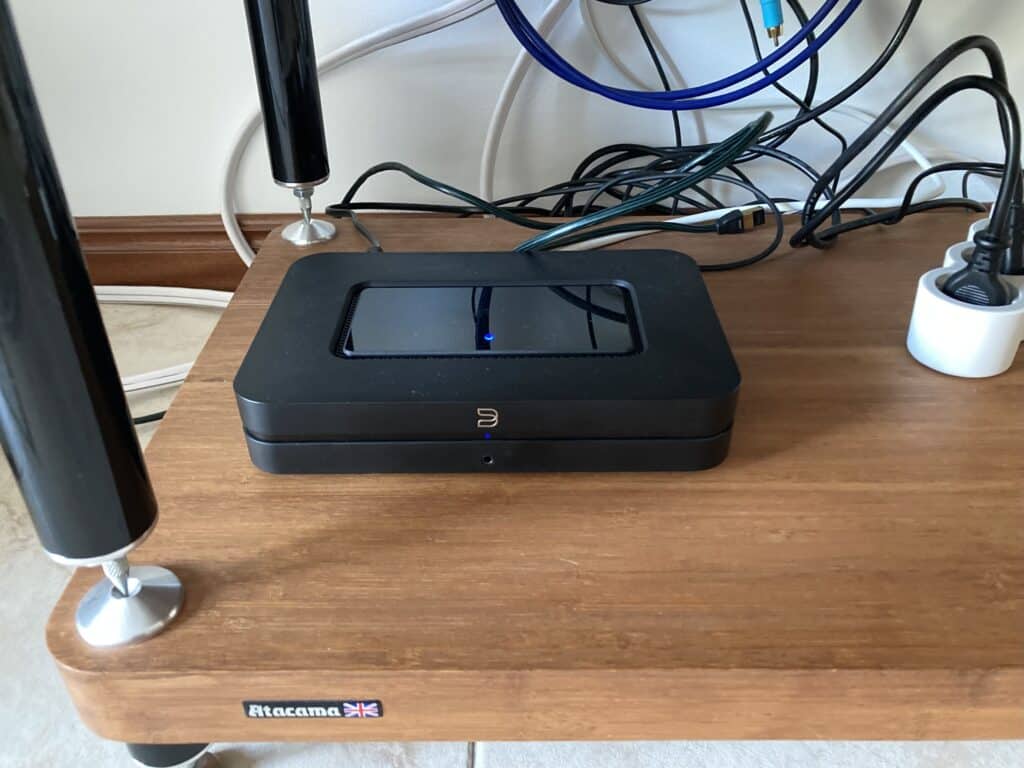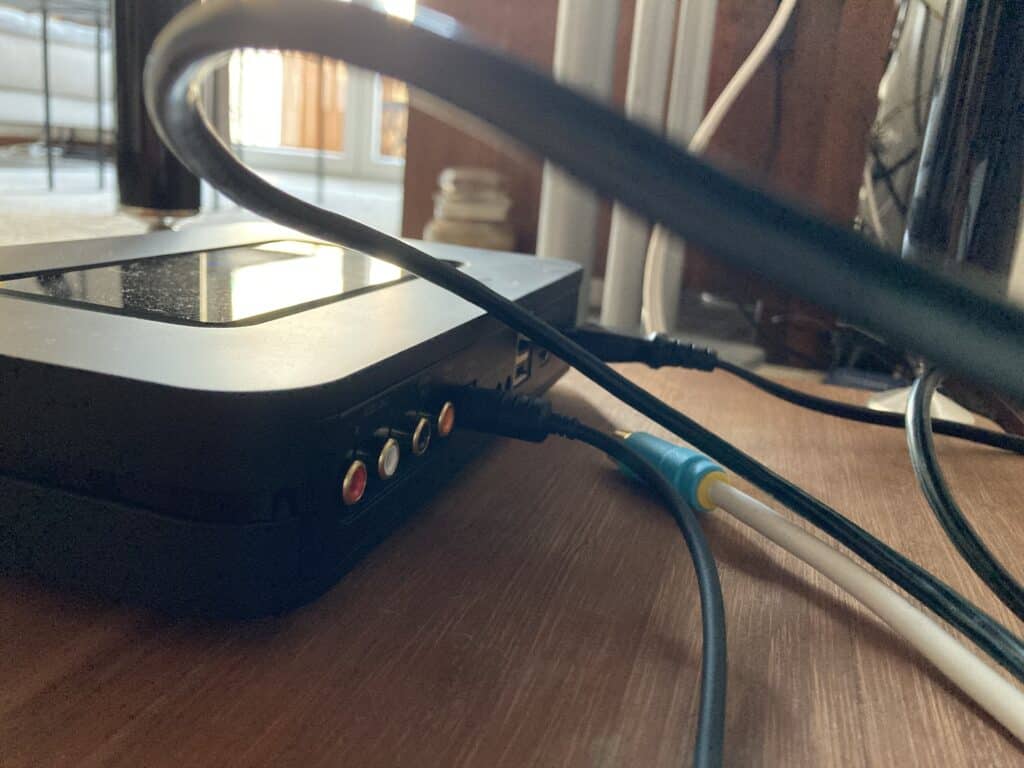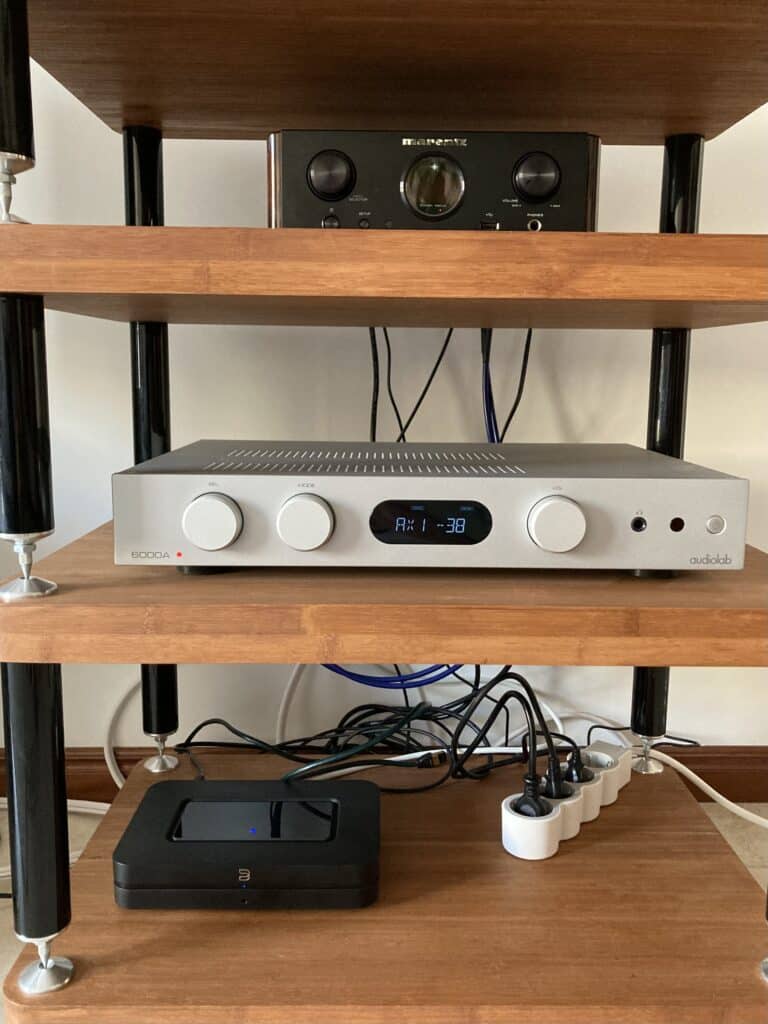Pros
✔️ Great and affordable way to stream Hi-Fi quality music
✔️ Supports commonly used audio file formats for local music libraries
✔️ Integrates with popular music services
✔️ Plenty of connectivity options
✔️ Easy setup and intuitive BluOS controller app
Cons
❌ Internal DAC may leave audiophiles wanting more
❌ Limited to PCM (no support for DSD2.8 or DSD5.6)
❌ Prone to picking up noise from switched-mode PSUs on the same distribution board
Streamsoundtech.com score: 🌟🌟🌟🌟 (4/5)
List Price: $549
For many, a network music streamer like the Bluesound Node 2021 (gen 3, N130) might seem something of a luxury. But if you are serious about listening to music at home, a dedicated device for audio streaming is a must have.
While some amplifiers now include the ability to stream music directly from a phone or other device over Bluetooth, this way of listening to music streaming services comes with some significant disadvantages. Not least the downgrade in sound quality experienced over Bluetooth but also the likelihood music will interrupted if you are using the device for something else at the same time. Streaming music over Bluetooth is a convenience feature best left for parties and not for listening to your favorite album uninterrupted.
If you are just starting out in HiFi, you might not want to splash out thousands on a music streamer. And that’s where the Node 2021 comes in. The Bluesound Node 2021 (sometimes referred to as the Bluesound Node 3, Gen 3, and 2021) replaces the previous generation Node 2i. It is a budget music streamer that lets you listen to music streaming services, like Spotify, Tidal, and Qobuz, plus music from your own local music library. It also has wireless multi room Hi Fi capability, allowing you to control your music listening experience and preferences around the whole house using one app. All you need is an existing stereo amplifier to connect the streamer to your speakers.

An upgrade to the popular Node 2i, the Bluesound Node 2021 comes with just about every feature you could dream of in a device at this price point. It has a built in digital to analogue converter (DAC) so you can connect the Bluesound Node 2021 directly to an analogue amplifier. As most amplifiers today some with built in DACs, there’s also the option to connect directly to an external DAC using coaxial cable digital outputs or TOSLINK optical. And for those who want to connect the Node 2021 to their home cinema, there’s even an HDMI eARC input for uncompressed audio.
In this review, I’ll look at how the Bluesound Node 2021 stands up when used to play music, listen to Internet radio stations, how easy it is to connect to different online streaming services like Tidal and Amazon Music HD, listen to your digital music library held on local network attached storage (NAS). Plus, the all important BluOS that’s used to power the device and the mobile app. I will also evaluate ease of use, sound quality, and how it stacks up the competition.
The Bluesound Node 2021 has the ability for high-resolution music playback using streaming services that support it. For example, Spotify has a maximum stream rate of 320 kbps. But services like Tidal and Qobuz can stream CD quality (16bit 44.1kHz) and high resolution audio, which is almost always 24bit 44.1kHz up to 192kHz. The internal DAC supports up to 32-Bit, 192kHz.
The Bluesound Node 2021 also supports MQA, a technology that packs hires audio into a stream that needs to be unpacked by the streamer to produce an audio signal that can be played back. Finally, consider that most Internet radio stations stream audio at between 100 and 320 kbps, most on the lower end of that spectrum.
Whatever streaming service you choose, the Node 2021 is likely able to decode the audio signal. Here is a list of the supported cloud music services:
If you are looking for music playback from your own local music library, then the following file formats are supported:
You can also stream internet radio stations using these services:
As previously mentioned, you are spoiled for choice here. Let’s start with the network connection options. You can connect the Bluesound Node 2021 to your home network using the gigabit Ethernet port or using dual band Wi-Fi 5 (802.11ac).

There’s also two-way Bluetooth support (Bluetooth 5.0 aptX HD) for streaming audio to the device. Bluetooth is quite handy when you want to stream music from a service not directly supported by the Node 2021, like YouTube Music. Or if you want to connect Bluetooth headphones to the Node 2021.
If you are invested in the Apple ecosystem, the Node 2021 supports AirPlay 2, which lets you stream music from Apple devices across multiple Node 2021 players. It even lets you walk from room to room while keeping your music in sync. Or you can choose to have different music playing in each room.
Audio outputs include everything you would expect. There’s a pair of analog RCA stereo phono outputs and you have the option to fix the volume output. There are three digital outputs, a coaxial RCA phono out, TOSLINK optical out, and USB out. There’s also an analogue RCA phono out for a subwoofer.
The Node 2021 includes a stereo 3.5mm headphone stereo mini jack and a 12 volt trigger out that can be used to turn an amplifier on and off to save power.
The HDMI eARC port is input only. The Type-A USB port can also be used to connect Fat32 or NTFS formatted USB memory sticks and supported peripherals for direct disk playback. There’s a Type-B mini USB port for product servicing.
If you choose not to use Tidal Connect, Spotify Connect, AirPlay 2, or one of the other system integrations like Control4, RTI, Crestron, URC, Push, iPort, ELAN, Lutron, or Roon, then you can use the BluOS app to control music wirelessly from an Apple or Android phone or tablet.
Out of all the popular music streaming devices on the market, Bluesound has the best controller app. I was able to seamlessly connect the Node 2021 to Tidal, Qobuz, and Spotify without any problems.

The device settings are neatly and logically organized should you need to change them. And the customizable home screen has shortcuts to recently played radio stations, most used music streaming services, a list of recently played tracks, plus any radio presets you want to add.
In addition to the ability to browse your own music collections in each streaming service, you can also search each service individually. The only bugbear I have about this feature is that if you choose to for example search Spotify, you search the entire service rather than the tracks and albums in your own collection. But this may be an API limitation imposed by the streaming services rather than a caveat of the BluOS controller app itself.
Connecting the Node 2021 to my network attached storage (NAS) was quick and simple. BluOS indexes all the files on the NAS so I can search quickly and get listening. And if you have more than one Bluesound device, the index is synchronized between all devices on the same network so there’s no need to create or update the index multiple times.
The only music streaming app that can better BluOS is Roon. But that comes at a significant extra cost. The quality of the controller app is especially important if you choose to use a service, like Qobuz, that doesn’t have the ability to ‘connect’ and control the Node 2021 directly through the native app. In short, the intuitive BluOS controller app is easy to use, it is fast, and it is a good choice to seamlessly stream music if you don’t intend to go down the ‘Roon’ route.
The Bluesound Node 2021 is discrete and it is made from plastic. While it might not scream high end to look at, it is fairly inoffensive and has soft touch finish. It’s available in both black and white versions. Because of the rubbery soft touch finish, it is prone to attracting dust. And there have been reports of the color fading over time, so it might not be a good idea to place the unit in strong sunlight.
Naturally, the plastic case is easily damaged if hit by something sharp or heavy. But otherwise, it is sturdy and the ports on the back of my unit have withstood constant plugging and unplugging over the past year.
The Bluesound was connected to the network using WiFi during testing. Secondly, when testing the RCA phono output of the Bluesound, it was connected to the amplifier using Chord Company Clearway analogue interconnects. When connected to the digital input of the Audiolab amplifier, I used a Chord C-Digital Coaxial Cable because in my experience, with similarly priced cables, coaxial sounds better than optical. When connecting the Marantz HD-DAC1, I used an Atlas Element USB cable.
I used Wharfedale 12.1 speakers for all the testing.
In this section, I’m going to review the Bluesound Node 2021 using the internal DAC. At the end, I will briefly comment on using an external DAC. The Node 2021 is ideally priced for those looking to get into streaming Hi-Fi quality sound without too much fuss. And that means connecting the internal DAC to an existing stereo amplifier using RCA phono cables.
I connected my Node 2021 to the aux ports of an Audiolab 6000a stereo amplifier. Let’s consider how it sounds in relation to the asking price. Regardless of what type of music you decide to play, whether it is jazz, classical, rock or something else, the Node 2021 delivers a neutral and well balanced sound. It’s not going to set the world on fire though – and at this price you probably wouldn’t expect it to.
The sound is pleasant and enjoyable. Instruments are well separated across the sound stage, which is wider than it is deep. The treble is detailed and the bass moves along nicely, even if it doesn’t dig very deep. In many ways, the sound reminded me of the Audioquest Dragonfly Red DAC. All very polite, pleasant, if a little ‘digital’ sounding.
At this price point, considering you are getting a streamer and DAC all in one box, you can’t really go wrong. If you want a more refined and musical experience, then you need to either opt for a higher-end streamer or invest in an external DAC.
Let’s see how the Node 2021 fares with an external DAC.
I tested my Node 2021 with the internal DAC on the Audiolab 6000a amplifier using the coaxial output on the streamer. The sound stage was considerably larger, more detailed and with significantly deeper bass. It had better pace, rhythm, and timing (PRAT) too. But over coaxial, there was just something missing from the sound. A control and poise that was present using the Node’s built-in DAC.

I also connected the Node 2021 to my Marantz HD-DAC1. This time using the USB out on the Node. The Marantz was a considerable step up from the Audiolab 6000a’s built-in DAC. The music is delivered with more heft, impact, transparency, and PRAT too. And with more poise, control, and sophistication than the Node’s built-in DAC. It’s a thoroughly enjoyable experience that once you’ve heard it, will make anything else seem quite pedestrian in comparison.
I believe a lot of the discrepancy between using the Audiolab 6000a and Marantz HD-DAC1 as external DACs comes down to the superior quality of sound delivered over the asynchronous USB interface compared to synchronous S/PDIF over coaxial. When I swapped out the USB cable for coaxial, it was like sucking the lifeblood out of the Marantz DAC.
The Node 2021 is a great and affordable way to get into streaming studio quality music. It supports the most commonly used audio file formats if you want to stream your own local music library and it integrates with the most popular music services. The connectivity options are plenty and I can’t imagine what else you might add.
The Node 2021 is simple to set up, the BluOS controller app is easy and intuitive to use, and in the year since I purchased it, I’ve had literally no operational problems with the device in various different usage configurations.
If you are used to listening to expensive hi-end stereo equipment, then the internal DAC may leave you wanting. But at the price and the market the device is intended for, the internal DAC is a great starting point that won’t disappoint. While the Node 2021 supports MQA, it doesn’t support protocols like DSD2.8 and DSD5.6, which you find on high-end DACs like the Marantz HD-DAC1. You are limited to PCM, which won’t be a problem for the target audience of this device as it is the protocol used by all music streaming services.
It’s not surprising at this price point to find the Node 2021 comes with a built-in switched-mode power supply (SMPS). One advantage of switched-mode PSUs is that you don’t have to worry about AC mains polarization; just plug it in and go.
The downside is that the PSU is prone to picking up noise from other SMPS’s on the same distribution board. When I connected a NAD 3020 DAC, which also has a SMPS, the noise the NAD’s SMPS produces is picked up directly over the headphone output of the Node. Very loudly. In short, you need to keep the Bluesound Node 2021 away from devices with a SMPS. Not only do they introduce noise into the Node 2021 but they also significantly reduce the sound quality.
In fact, when the Bluesound Node 2021 is a component in my system, I am only able to get a decent sound out of it by making sure it is placed last in the chain on the mains distribution block. I.e. the power amplifier is placed closet to the power inlet, followed by the DAC, and the Node 2021 last. Both the Marantz DAC and Audiolab 6000a have high-quality linear power supplies.
At the price point, there is one other serious competitor: the Cambridge Audio MXN10, a new device set to rival the Node. I look forward to comparing it with the Node 2021 in the near future.
I mentioned above that I was testing using the Bluesound Node’s Wi-Fi connection. That is true. But I want to comment here briefly about how it sounds using Ethernet. I used a MeiCord Opal Ethernet cable connected to a Netgear GS105 switch. The resulting sound produces a bass that digs deeper than on Wi-Fi and it is more open in the midrange.
If you are looking for your first music streamer, then the Node 2021 should be on your shortlist. It’s hard to go wrong with this device. With support for Tidal MQA, the best controller app out there, and a decent internal DAC so you can get up and running with your existing stereo amplifier or powered speakers, it’s hard to go wrong with the Node 2021 at this price point.
🛒 Bluesound Node 2021 (List Price: $549)
This article contains affiliate links that help fund this site and future reviews. By clicking them, you help support me write reviews like this but it doesn’t cost you any more.